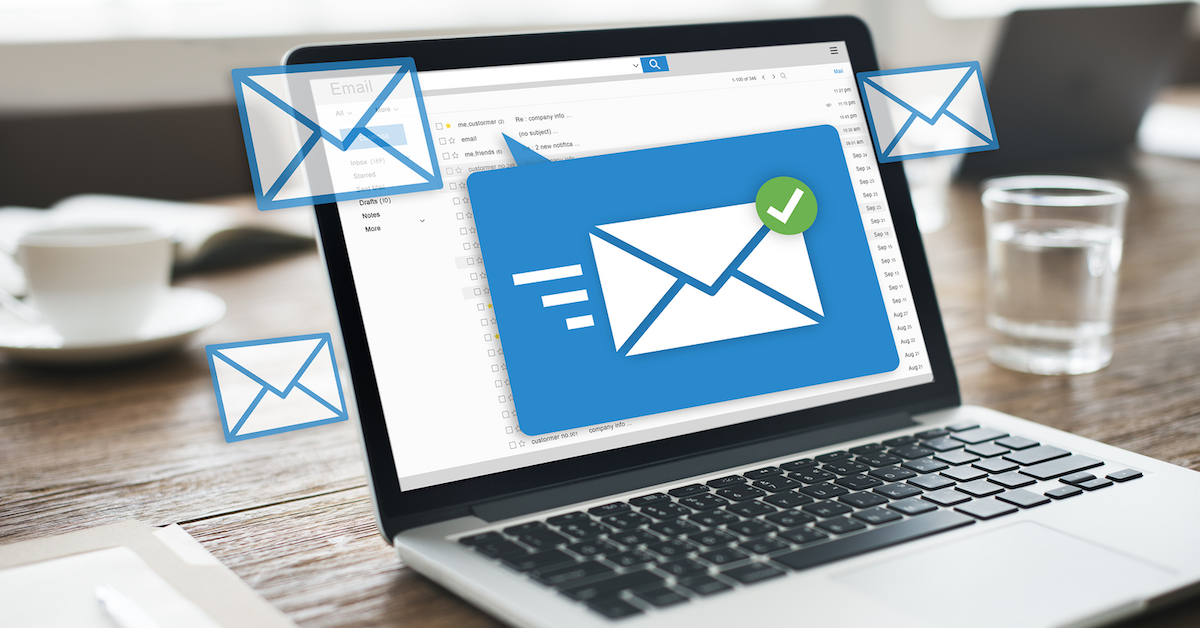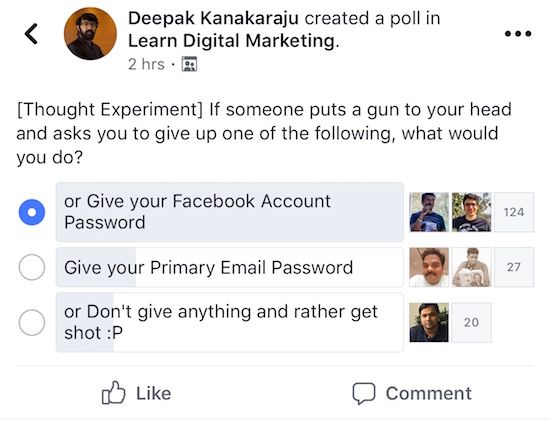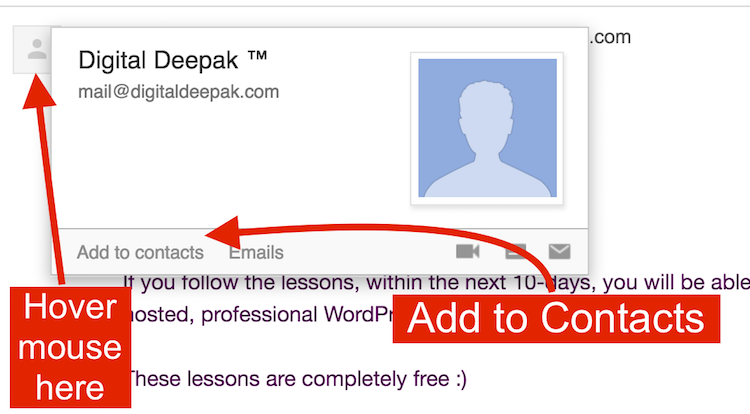7 Ways to Land Your Emails in the Primary Tab of Gmail

Many people have asked me this question over the past few months. I’m writing this blog post to give a detailed answer on it. Gmail came up with multiple tabs and now, most of the emails from marketers land in Updates or Promotions tab which affects visibility and open rates.

Most of my emails to my 2,50,000+ subscribers land in the primary tab and I get open rates as high as 40%. There are a few tactics that I follow to achieve this.
Many have given up hope on email marketing due to deliverability issues and low CTRs. But that is also an advantage for marketers who can use it in the right way – because you have less competition in the inbox!
The topics discussed in the post not only helps you with subscribers using Gmail, but it will help you increase your email delivery and open rates across all subscribers using any email service.
1. Deliver Value on Emails
Most of the marketers and bloggers are comfortable delivering value on blog posts and YouTube videos. However, email is mostly seen as a promotional channel than a value delivery channel.
If you do not deliver value on email, you are not going to get people’s attention in the inbox. An email inbox is a very personal space and a great way to build friendship with your followers.
In a recent poll conducted on my Learn Digital Marketing group on Facebook, 78% of the respondents voted that, given an option, they would rather give up their Facebook account password than their primary email password. That’s how important email is.

You should make sure that subscribers get something of value that they will not get otherwise on other channels like your blog or YouTube channel. Make content exclusive for your subscribers.
When people subscribe to my email list, I deliver value for at least 30 days before I promote something on email. My best lead magnet so far is the free 25 part digital marketing course I’ve designed. This is available at LearnDigitalMarketing.com and also through various opt-in methods on my blog.
The links to the video lessons are available on my email newsletter only. That way, the open rates are high, spam complaints are low and people are less likely to unsubscribe because they are getting so much value.
2. Ask People to Add Your Email to Their Contacts
If your sending email ID resides in the contacts list of your subscribers, there is a higher chance of your emails landing in the Primary Tab, and almost guaranteed that it won’t land in their spam folder.
I show this image to people when they subscribe to my free courses. They are in the thank you page. Since of my subscribers use Gmail or Gsuite, I ask them to do this:

This is something that you should keep reminding people to do. Apart from having this on the thank you page after optin, you can also add this message on the signature of every broadcast and drip email. You might have noticed this on the emails that I send.
3. Ask People to “Drag” Emails into Primary Tab
There is an old saying which goes like “Ask and it is Given”. There is even a book on that topic. Sometimes, all we need to do is ASK!
As soon as people subscribe for my email newsletter, I ask them to drag the first welcome email from the Updates Tab to the Primary Tab. Most of the follow up emails have a high chance of landing in the Primary Tab if people drag one email from Updates to Primary.
These are the screenshots that reside in the thank you page of my newsletter subscription.
The first screenshot instructs people to drag the emails from Updates to Primary.

The second screenshot asks them to click Yes to confirm.

Not everyone does this step. Though I cannot track it accurately, I believe I get around 20-30% of the people to get to do this. Which means that these 20-30% subscribers almost always will get the emails to the Primary Tab.
4. Send Plain Text or Light HTML Emails
If you are getting an email from your friend, it is never in the form of a nicely designed HTML template. It would be a plain text email. When people receive targeted communication, they like to get plain text emails that are to the point and easy to read.
99% of my emails have been plain text emails. I’ve never had the time to design HTML emails and never had the need to. I’ve noticed that HTML emails with nice designs are nice to look at but at the same time it doesn’t feel personal for the subscriber. And it doesn’t land in the primary tab.
There is one downside to plain text emails. You cannot track the open rates because without HTML you cannot load the script that tracks if people have opened the emails. One alternative to this is to send a very basic HTML mail that resembles plain text email. Such emails help you track the open rates and also allow you to add an image or two. You will also be able to create anchor text links within your email.
I used to send only plain text long back, though the CTRs are great, I like to add anchor text links to the emails. Most of the emails that I send nowadays are HTML emails which look like plain text ones.
5. Keep Emails Short and Have Fewer Links
Imagine how would your friend’s email look in your inbox? Short, to the point, no images and never more than 3 links. Now think about how your subscribers would want to get emails.
A 2-page email with 20 outbound links is obviously a promotional email and has no reason to land on the primary tab of Gmail.
I write all my emails as if I am sending an email to a friend of mine. Except it goes out to 2,50,000+ subscribers. This is another secret that I use to land the emails in the primary tab. This is a factor that has not been explicitly discussed by any of the email service providers.
However, note that just because you keep the emails short and have less number of links doesn’t guarantee that the mails will land in the primary tab or even the inbox. There is a combination of factors and this is just one of the factors.
6. Build Your Sender Reputation
Email service providers like Gmail look at various factors when they get an incoming email. Based on the factors they can decide one of the four things:
- Not deliver the email at all
- Place it in the spam folder
- Place it in the Updates/Promotions Tab
- Place it in the Primary Tab
The sender ID is a combination of the from email ID and the IP address from which the emails are sent. I’ve been sending emails for the past 6 years using just one email ID and that’s mail@digitaldeepak.com
I don’t have my own email servers yet and I use third party providers like Aweber and Drip to send the emails. The IP reputation of these services are quite good and there is no problem in getting good deliverability of the emails. A good email server combined with all the above factors will help you deliver your emails to the Primary Tab of Gmail users.
If you are a long term customer of these service providers and if you have less bounce rate and spam complaints, these email providers will place you in high reputation servers so that you can get good delivery rates over time.
If you are having a history of high bounce rate and spam complaints, then these services might kick you out. Else they might place you on servers which have less reputation with the ESPs (email service providers).
7. Authenticate Your Domain with DKIM and SPF
DKIM and SPF are authentication methods for your domain name. Usually, the sender email ID will be you@yourdomain.com – and it is better to authenticate yourdomain.com as the sender.
According to MailChimp: “Authentication is critical to the delivery of your campaign, and works like a license plate for email. It provides a trackable identifier that shows your subscriber’s internet service provider you’re a legitimate sender, and it helps your campaign arrive in the inbox.”
We are venturing into technical territory. You don’t need to understand the technical details of DKIM and SPF completely. Even I do not. However, we can understand the simple logic behind it and do the steps necessary for authentication.
There are two important types of authentication to consider when sending email:
- DomainKeys Identified Mail (DKIM) and
- Sender Policy Framework (SPF)
1. DomainKeys Identified Mail (DKIM)
DomainKeys is a standard for authenticating email developed by Yahoo. But DKIM is now used by almost all the email service providers and it is one of the important standards in email authentication.
According to Wikipedia:
DomainKeys Identified Mail (DKIM) is an email authentication method designed to detect email spoofing. It allows the receiver to check that an email claimed to have come from a specific domain was indeed authorized by the owner of that domain. It is intended to prevent forged sender addresses in emails, a technique often used in phishing and email spam. In technical terms, DKIM lets a domain associate its name with an email message by affixing a digital signature to it. Verification is carried out using the signer’s public key published in the DNS.
If you are using a premium DNS service such as Route 53, the steps are relatively simple. Else, most of the domain name providers give you a DNS management console. You just need to add TXT records in your DNS management console. The keys differ based on the email service provider that you use. Some email service providers make it mandatory to setup DKIM if you want to send emails using their servers.
For example, if you are using MailChimp, here’s the documentation for MailChimp. Check out the documentation on Amazon for further details if you are using Route 53 and Amazon SES to send emails.
If you cannot find the documentation for your email service provider, contact their support team and they will help you with further details. A few email service providers do not support DKIM.
2. Sender Policy Framework (SPF)
Google has published documentation on SPF. SPF is another standard/framework which works in parallel to DKIM. The official website of SPF is www.openspf.org.
According to Google:
We recommend that you create a Sender Policy Framework (SPF) record for your domain. An SPF record is a type of Domain Name Service (DNS) record that identifies which mail servers are permitted to send email on behalf of your domain. The purpose of an SPF record is to prevent spammers from sending messages with forged From addresses at your domain. Recipients can refer to the SPF record to determine whether a message purporting to be from your domain comes from an authorized mail server.
I am using Aweber for most of my outgoing email. According to Aweber’s documentation, all I need to do is add “v=spf1 mx include:send.aweber.com -all” as a new SPF record in my domain name’s DNS.
Since I am using Route 53 for my DNS, you can see that I’ve added this to my Route 53 console:

DKIM and SPF are good standards but they are getting old now. There is another new standard that is coming up called DMARC. Covering all aspects of DMARC is beyond the scope of this article and I will be publishing a separate article on that soon!
These standards will become more important as we move forward because ISPs and ESPs are going to become strict with spam. The number of spammers in the world is not going down and as people start using email more for their daily communication, the right checks will help get email from the good guys delivered to the inbox.
Final Words
Having said all this, there is still a chance that your emails might land in promotional tabs or even the spam folder. Just make sure that you follow as many points as mentioned above to get maximum number of emails delivered, in the inbox, hopefully in the primary tab.
Do try out these tips and let me know if it worked for you!
Any questions? Leave a comment below!
Cheers,
Deepak
P.S. Ok, here’s another powerful bonus tip that you can copy from me. I try to convert as many subscribers as possible into paying customers, by selling very low cost products. For example, I sold an ebook for Rs.25, and I had 1,000s of customers. Once they become a “customer” my communication becomes transactional than promotional! I send product updates on email – this way they will never unsubscribe to my emails! I can send promotional emails under the guise of transactional emails – like “Additional discount on XYZ for my existing customers only”. This also helps increase the sender reputation because the engagement on these emails is super high!